The world of horses has many names, descriptions, and terms for just about everything there is to differ on a horse. One word you might hear pop up from time to time is “buckskin” – just what does it mean and how does it apply to a horse?
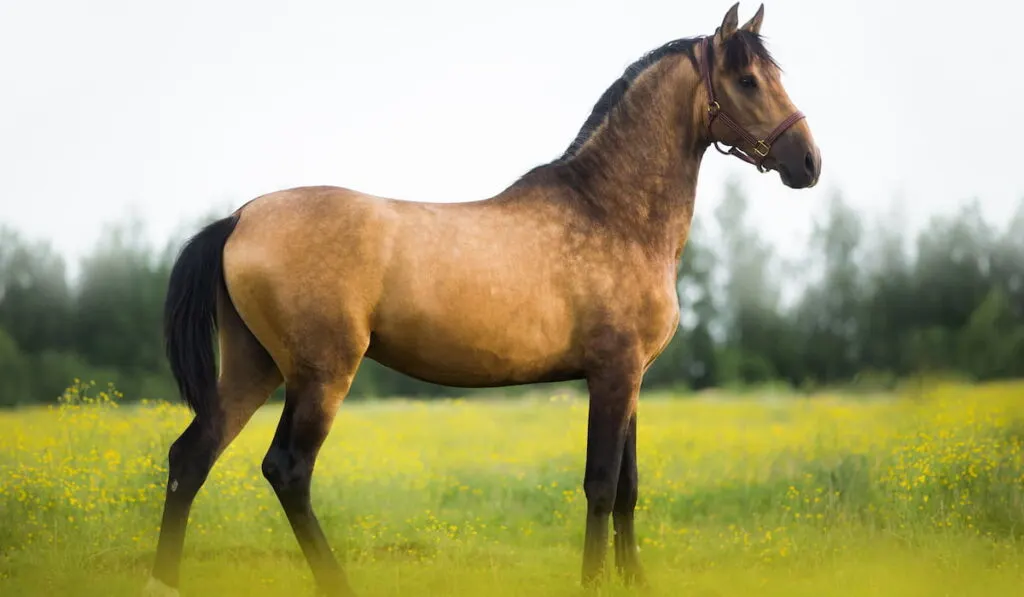
Table of Contents
What Exactly Is a Buckskin Horse?
Though the term “buckskin horse” sounds like it can describe both a breed and a color, it only refers to coat color.
A buckskin colored horse coat is a tannish, golden coat color, similar to that of tanned deerskin. The mane, tail and legs will be solid black. Eyes are typically brown but may be blue if other genes are present.
True buckskins are noted by their contrasting black points: that is, black manes, black tails, and black lower legs. Those tails, too, may have something called a “frosting”, which refers to white or lighter hairs mixed in with the tail, giving it a frosted appearance.
Similar to a palomino, a buckskin horse can range over a number of shades, from quite light to a muddled kind of gold. Also, in that same tradition, a horse of any number of different breeds can be born as a buckskin.
Buckskin Origins
According to Oklahoma State University, the earliest traces of buckskin horses can be found in Spain, in the Spanish Sorraia. Spanish horse enthusiasts were, in the Middle Ages, quite determined to breed a horse of a golden color.
As Spanish explorers began immigrating to the Americas, they brought with them these golden horses, introducing genetically true buckskins to the new world.
The fact that a buckskin’s ideal color is similar to that of deer hide is, also, where its name came from: quite literally, their coat should look like the skin of a buck (a.k.a. a male deer).
Buckskin Coat Color Genetics
The buckskin makeup is all very scientific and all comes down to a single cream dilution gene.
For the buckskin coat to occur, a cream dilution gene must be present on an otherwise bay horse.
Since bay horses have: a brown coat, which mixes with the cream to create a tan color and a “black base coat” gene, the agouti gene, restricting that black coat to the tail, mane and leg points.
The one copy of that cream gene lightens the bay to tan and still allows for the black points to exist. It is for this reason that genetically true buckskins possess those black points, rather than solidly tan features.
In order to foal a buckskin, at least one parent has to have that cream gene. What makes buckskins further unique is the fact that not all breeds carry the cream gene.
The good news is, many common breeds do including mustangs, Quarter Horses, Morgans, and Tennessee Walking Horses.
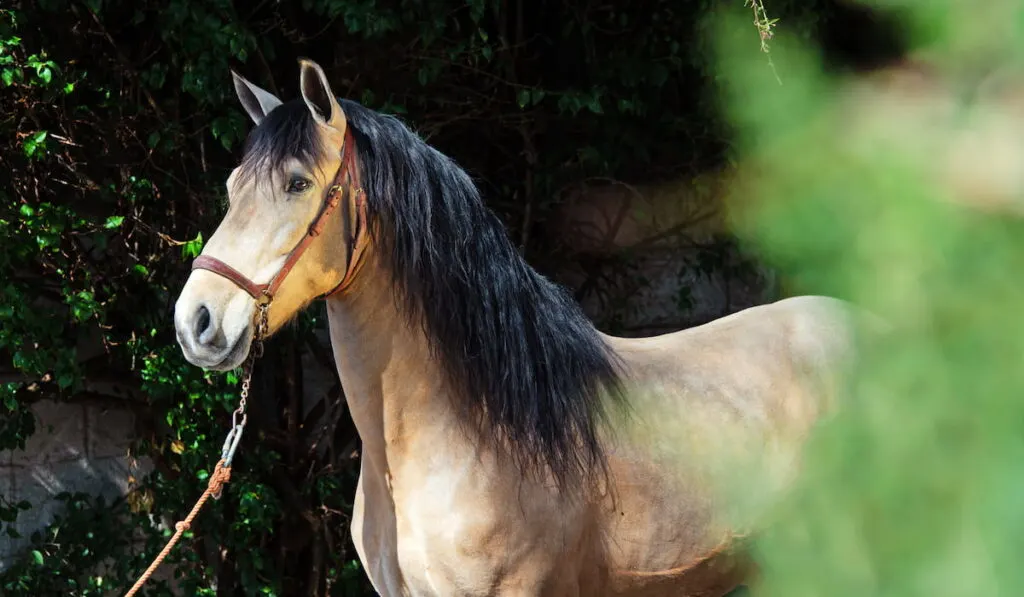
Genetic Representation of a Buckskin
Coat color testing has provided horse lovers a way to 100% verify their horse’s true color. A true buckskin horse would have one of the following results on an equine coat color test.
The cream gene is represented by the letters Cr when present and cr when not present. Buckskin horses always have only one copy of cream and since genes always come in pairs, this is designated Crcr.
| EEAACrcr | Homozygous Black Gene and Agouti. Heterozygous Cream. 50% of offspring will be bay and 50% will be buckskin in absence of other color modifiers. |
| EEAaCrcr | Homozygous Black Gene, Heterozygous Agouti. Heterozygous Cream. All offspring will be black based but could be a variety of colors. 50% of offspring will inherit the cream gene. |
| EeAACrcr | Heterozygous Black Gene, Homozygous Agouti. Heterozygous Cream. Offspring will be chestnut, bay, buckskin, or palomino (in absence of other modifiers). |
| EeAaCrcr | Heterozygous for black and agouti. Heterozygous Cream. Any color offspring are possible. |
Not All Breeds Have Buckskin Horses
What further defines the special parameters of a buckskin coated horse is that at least one parent must carry the cream gene in order to breed a buckskin foal, and not all breeds do carry that.
Purebred breeds that cannot be buckskin include Arabians, Friesians, Suffolk Punch, Belgian and Shire Horses.
Buckskin As A Horse Breed
Due to that unique nature of a buckskin coat, sometimes it is classified as a color breed (a registration of horses based solely on coat color and not pedigree), though, because of the genetic makeup needing one dilution allele, not two, this coat color can never be a consistent true-breeding (purebred, passing down consistent genetic material) trait.
Also, because of that, it is not guaranteed that breeding a buckskin to another buckskin will result in a buckskin foal.
Because of the heterozygous nature of the cream gene (being a single copy), they can produce any range of base or cream color coats.
Following recessive and dominant trait math, two buckskin parents have a 25% chance of producing a base color foal (bay, chestnut or black), a 25% chance of a double cream dilute foal (cremello, cream or perlino) and a 50% chance of some type of single dilute foal, though not necessarily a buckskin (buckskin, palomino or even smoky black).
6 Common Shades of Buckskin
Since buckskin coats can vary over a wide range of shades, from light to dark, every color on the coat spectrum has its own shade name. (source)
1 Genetic Code – 3 Different Colors
For the first three, as far as we know the genetics are the same and the phenotypic, or expressed, color varies seemingly at random from individual to individual. This is much like how two people with blue eyes could have entirely different shades of blue.
Cream or Buttermilk Buckskin
Buckskins with a golden coat color so light it looks like soft, milky (or creamy) yellow. They have the lightest coats in the buckskin rainbow. True to genetic form, though, they still have the black points.
Standard Buckskin
The most recognized and ideally desired coat to be a true buckskin. The standard buckskin coat color looks like deer hide that’s been tanned.
Golden Buckskin
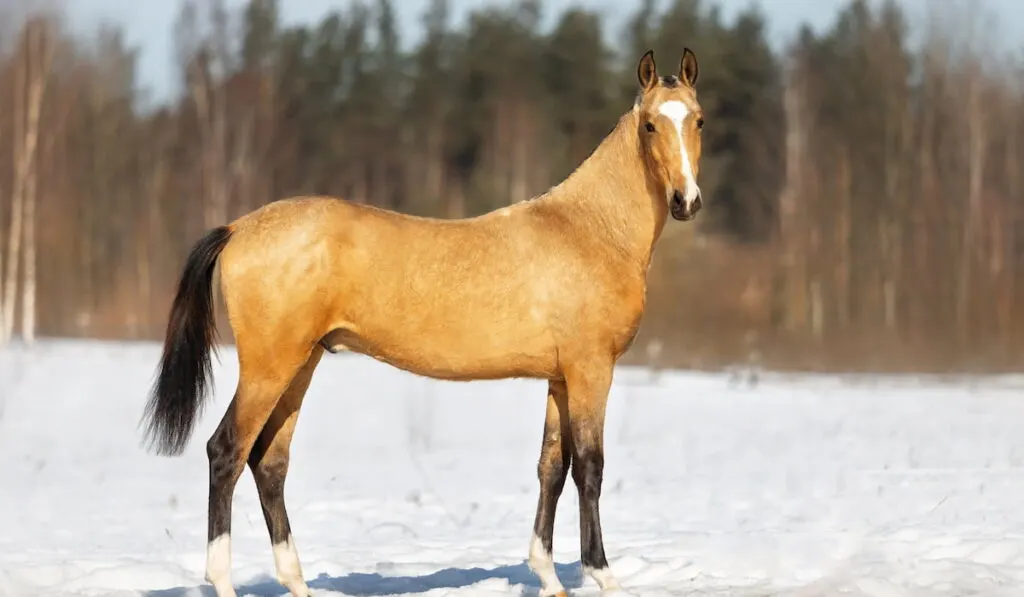
Technically a lighter version of a sooty buckskin, the golden buckskin looks rather like a standard buckskin but with darker shoulders and a darker back (NOT with a dorsal stripe, however).
Different Genes Creating Different Shades of Buckskin
In the case of the three buckskin coat color variations below, there is some evidence (and in the case of “Black” buckskin, proof) that different genes are at play.
A variation of the Agouti gene, labeled “At” is theorized to be the reason some horses that are genetically bay appear to be brown instead. Unfortunately, only one lab offered the test for At and it is no longer in business.
Sooty or Burnt Buckskin
These horses are genetically a buckskin color breed, as they possess both the bay and the cream dilution genes. They have a much darker coat, though – one that does not look nearly as diluted as a standard buckskin. The term ‘sooty’ comes from the fact that they have a darker topcoat over top a lighter undercoat, giving the impression of having had soot dumped on them.
Brown Buckskin
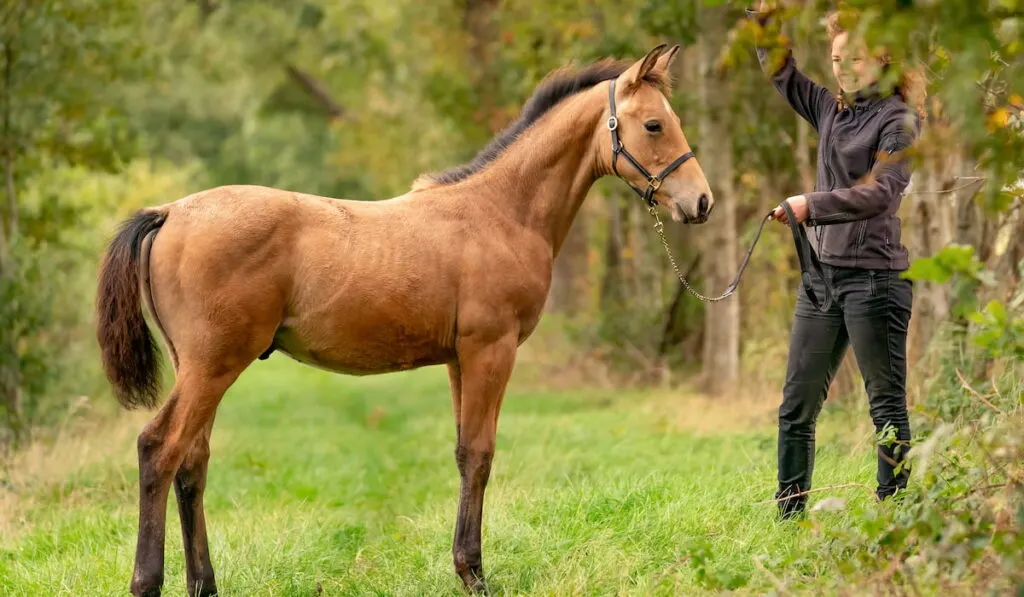
Brown buckskins, like black buckskins below, are often presumed to be brown in color until they produce a foal that is obviously dilute.
Brown buckskins typically have a brown base coat with a single cream gene. The brown coat color is theorized to be controlled by a specific version of the Agouti gene called At.
Silver Buckskin
The term “silver buckskin” can be used to describe horses of varying coat colors. I have heard it used interchangeably with buckskin horses that were going gray and buckskins with roaning as well.
Used properly, a silver buckskin is a horse that is buckskin and ALSO carries the silver gene. While the silver gene is common in some gaited breeds, it is rare in many common breeds and completely absent in others.
Since a true silver buckskin would have to be bay based and carry both the silver and cream gene, finding a horse with this color would be somewhat difficult in most breeds.
Typically a true silver buckskin horse appears to be a very light buttermilk color with a white or light tan mane and tail.
**Black Buckskin
Also referred to as ‘smoky black’, these buckskins are not necessarily true buckskins, since they are the result of a cream dilute gene and a black coat gene, rather than a bay.
They commonly get lumped in with traditional buckskins, however, but can also be called ‘dilute blacks.’ Most people agree the correct name is “smoky black”. A “black buckskin” has a black base, no agouti, and one cream gene. They would appear EEaaCrcr or EeaaCrcr on a genetic test.
Buckskin vs. Dun
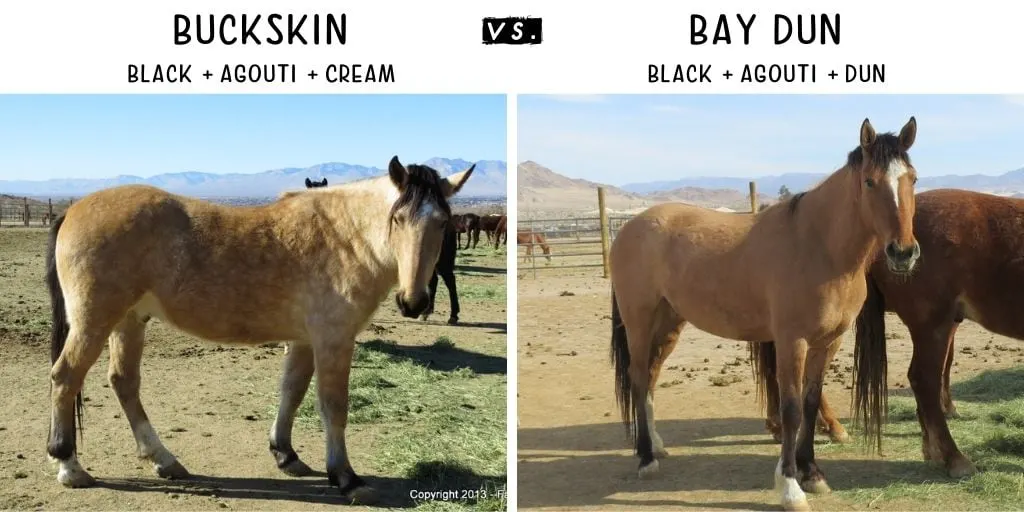
Buckskin and dun may look the same and you may have heard the term interchangeably, but they are actually two very different things. Though they both refer to pretty golden tan coats, they aren’t the same, and it comes down to genetics.
Both buckskins and duns are the result of a dilution gene acting upon a bay horse, but there are differences in produced color because they are different dilution genes.
Buckskins, while they can range from pale yellow to deep gold, are considered a true buckskin when their coat is the color of tanned deerskin. They will have black points seen in their manes and tails and solid black legs. Solid meaning absence of stripes, not the absence of socks or other white markings.
Duns, in this case “bay duns”, can range from light yellow to even a reddish-brown, almost chestnut, with legs that are a darker color or shade than the body. They also sport interesting primitive markings, with the most prominent being a dorsal stripe (or dark line) running down the back all the way to the base of the tail.
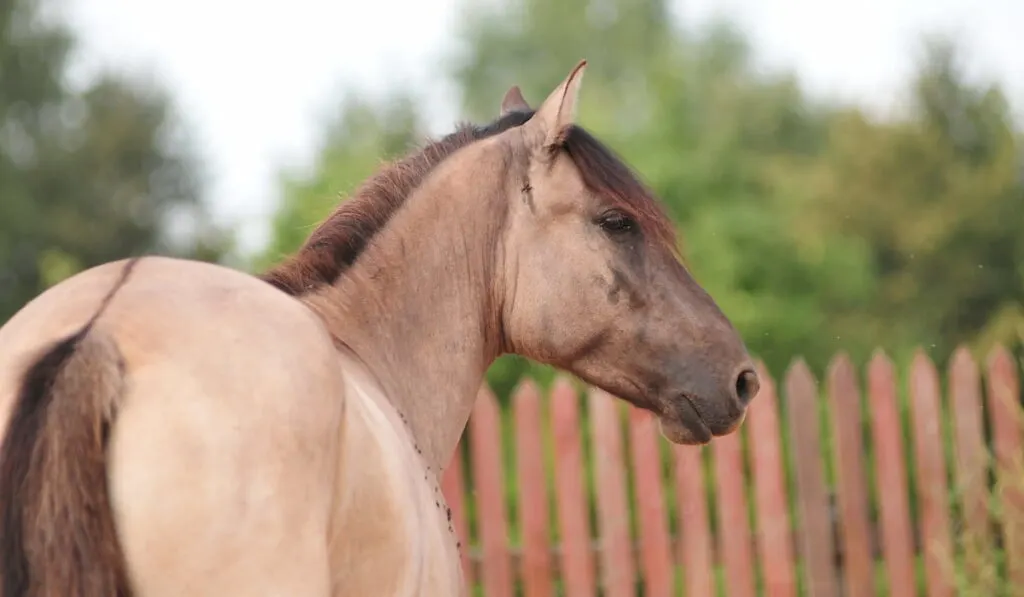
Dun horses also typically have horizontal striping of some sort that marks their shoulders, lower legs and/or foreheads. The dun gene isn’t limited to bay horses. It is a dilution gene, just like cream, that alters the base color. It is typically represented by “D” when present and “d” when not.
Can a buckskin have a dorsal stripe? Yes, a buckskin horse can have a dorsal stripe but a closer look at the pedigree, or DNA coat color testing, would be necessary to determine if the stripe is the result of a Dun gene or caused by countershading.
Because of that cream dilution on a bay, it is easy to mistake a buckskin for a dun horse if you don’t know to look for the primitive striped markings of a dun.
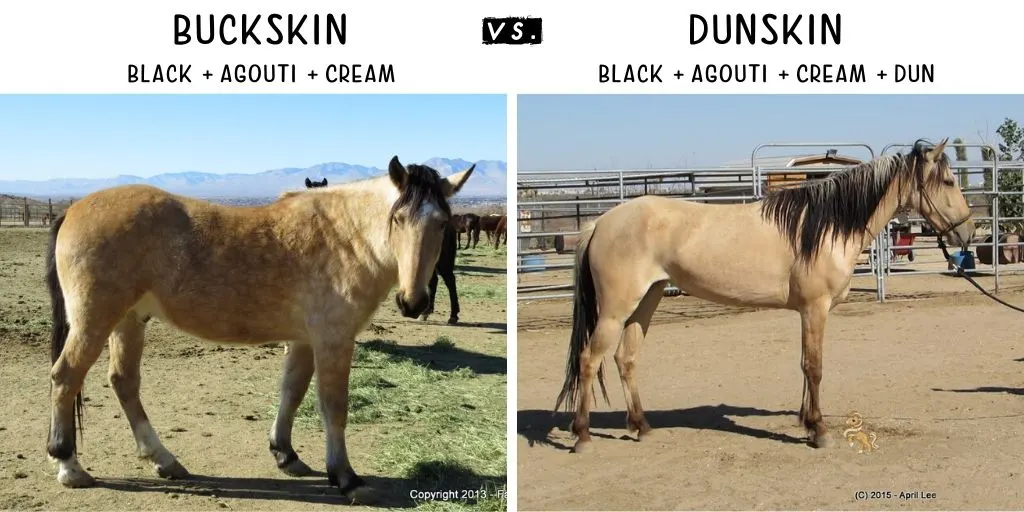
Genetically, horses that have a dorsal stripe (even if they also have the frosted tail of a buckskin) or who have leg striping, carry the dun modifier. If they also have the cream gene, the correct name for the color would be “dunskin” and not buckskin.
A dunskin is just a horse that has a buckskin base with a dun gene layered on. In fact, the colors are so common they often get confused, even by the experts.
All of the above assumes we are talking about true duns and not horses with countershading. “False” duns do exist but they’ll be covered in an article specifically for Dun horses.
Horse Colors With A Buckskin Base
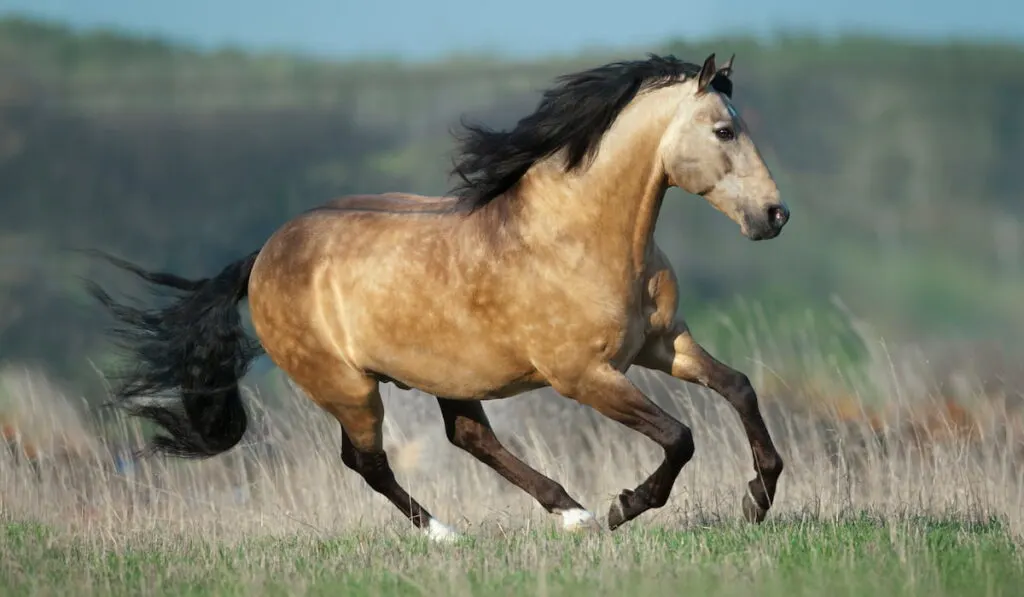
At this point, you know what genetic combinations make up a buckskin. You need at least one dominant black gene, one agouti gene, and a single cream gene.
Of course, there are a variety of other awesome coat colors that have a buckskin base. Here are a few:
| Dunskin | Buckskin + Dun |
| Buckskin Roan | Buckskin + Roan |
| Dunskin Roan | Buckskin + Dun + Roan |
| Silver Buckskin | Buckskin + Silver |
| Amber Cream Champagne | Buckskin + Champagne |
| Sable Cream Champagne | Brown Buckskin + Champagne |
| Gray (with a Buckskin Base) | Buckskin + Gray |
| Buckskin Tobiano | Buckskin + Tobiano |
| Buckskin Overo | Buckskin + Overo |
| Buckskin Tovero | Buckskin + Tobiano + Overo |
Buckskin Horses Color Change
Buckskin horses will often change color from season to season. Some shades of buckskin can even go through quite a drastic color change between winter and summer.
This is a BLM mustang mare I once owned. The first picture is of her at the BLM holding facility during the heart of winter. The other three pictures are varied throughout the seasons and show how much color change occurs.
This mare actually had more color changes than this and would even get big beautiful dapples.
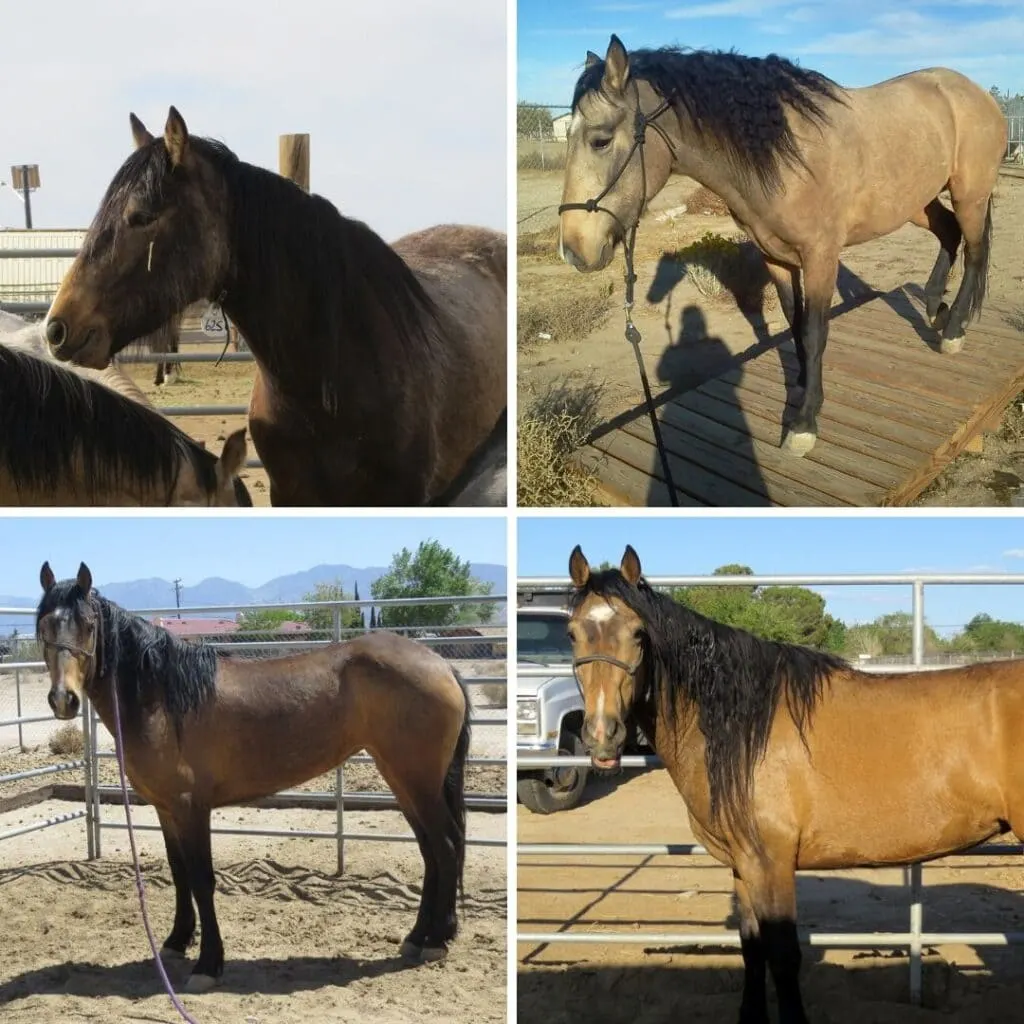
Famous Buckskin Horses
A color all but synonymous with the old west, you’ll find most famous buckskins in either western films or as having belonged to actual rodeo stars.
- Buttermilk, 1941 – 1972, was the buckskin quarter horse mount of famous cowgirl, Dale Evans. (source) He appeared in many western films and even was ridden by Evans with her husband, Roy Rogers, on The Roy Rogers Show in the 1950s. (Roy famously rode a palomino named Trigger).
- Hollywood Dun It, 1983 – 2005, is technically a dunskin (buckskin with dun). This legendary AQHA stallion was a reining horse champion who earned over $65,000 in the show ring. His offspring have won over $6 million dollars in competition. (source)
- Ranchboss Cortez, b. Apr 1999, is a beautiful buckskin foundation Morgan stallion. He has obtained multiple supreme championships and does an impeccable job showcasing the versatility the Morgan breed is known for. (source)
Buckskins were also featured on Bonanza, with Ben Cartwright’s mount being one. You also will have seen buckskins in Dances with Wolves. Though not a flesh and blood buckskin, Spirit, of Spirit, Stallion of the Cimarron fame, is a world-famous animated buckskin (dunskin).
Buckskin Horse Registries
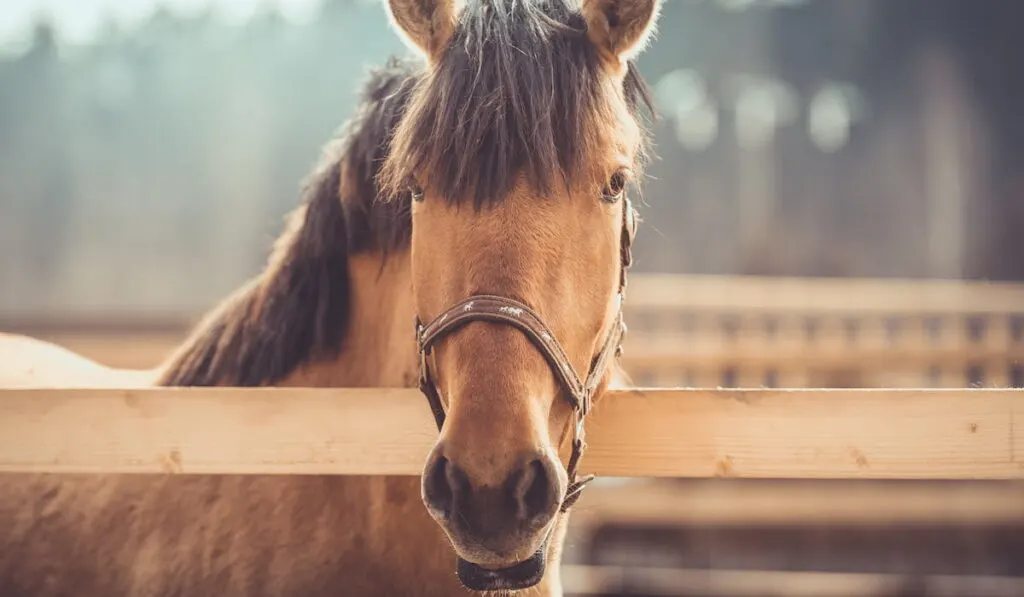
The buckskin has the distinction of having two separate registries that are available to it, one strictly being for American buckskins and the other being open to horses all around the world.
American Buckskin Registry Association
The first society, the American Buckskin Registry Association (ABRA), was founded in 1965. Though it is primarily known for registering true buckskins, it also records the pedigrees of duns, grullas and dunalino horses, ponies, and mules.
The registration places no stipulation on breed requirements, other than a horse meets the genetic requirements and coat requirements to be a buckskin.
Even horses that are of unknown parentage and whose genetic makeup may be a mystery are eligible to register if they meet the color requirements through their Hardship Registry.
In 2017, the ABRA added a Buckskin Bred Program to record horses who have buckskin parents but were not born with a buckskin coat themselves.
International Buckskin Horse Association
Since 1970, the International Buckskin Horse Association (IBHA) has been registering genetically true buckskins, as well as duns and grulla horses, to track and preserve pedigrees.
To register a buckskin, they must classify it as being that color of tanned deer hide and having black points, or at least being of a shade varying from yellow to dark gold with points that are dark brown or black. No registered buckskins can have any muddling in their colors.
They do not accept horses that are in possession of Albino, Appaloosa, Paint or Pinto characteristics, as those are different color breeds entirely.
Similarly, palominos that are in possession of a dorsal stripe are still not eligible as duns, and not horses that are chest, gray, bay or a line back sorrel are recognized. However, as of 2016 the registry does allow for miniature horses that are color eligible!
Registries That Accept Buckskin Colored Horses
The cream dilution gene is fairly common in many breeds, particularly stock horses and gaited horse breeds. Here are just a few of the many breeds that accept buckskin horses.
- Gypsy Vanner. While Gypsy Vanner horses typically have one or more pinto genes, some members also carry the dilution genes. Black and white horses may be the most commonly seen but buckskin Vanners are absolutely a possibility!
- Thoroughbred. When you think of horses racing on the track, one of the colors you are not likely to see is buckskin. Even so, the cream gene is present in the Thoroughbred. It is still a very rare color for the breed, but absolutely possible. In fact, Guaranteed Gold is a purebred cremello Thoroughbred stallion who often produces buckskins when bred with black-based mares!
- Tennessee Walker. Did you know that this fancy gaited horse breed also comes in buckskin! If you are looking for a smooth-riding buckskin, a Tennessee Walker might do the trick!
- Andalusian. If you are looking for a buckskin horse with a beautiful long mane and tail, Spanish profile and natural penchant for dressage look no further than the Andalusian horse. Black, bay and gray may be the most common colors for this majestic breed but they absolutely come in buckskin as well!
- Miniature Horse. Looking for a buckskin horse in a pint-sized package? If so the miniature horse is perfectly suited for the job. Typically standing at around 3 foot tall at the withers (34 – 38 inches), a mini horse is a perfect way to get the color you want in a horse that’s small enough to load into a mini-van!
- Shetland Pony. Whether you need a cart pulling pony or something for the kids to ride on, a shetland pony is a perfect option. Larger than a mini but smaller than a horse, the shetland is another beautiful breed that comes in buckskin!
Breeds That Don’t Have Buckskin Horses
While buckskin horses may be common, there are some breeds that don’t have this color at all. It is 100% impossible to find a buckskin horse amongst the purebred members of these breeds.
- Friesian Horse. If you read my article about Friesian horse colors, you know they come in black. (Well, very rarely chestnut too). One-color that is not present in the breed, buckskin. Purebred Friesian horses lack both the dominant Agouti gene and the cream gene required to make a buckskin horse. So if you see a buckskin Friesian, you can be sure it is a cross!
- Arabian Horses. Here is yet another breed where buckskin is not a possibility in purebred members. The Arabian horse breed does not have cream. As such, purebred Arabians are impossible to find in a few different colors including buckskin and palomino. There are some horses that are buckskin and look purebred, but you will always find they are registered as half-Arabians.
- Suffolk Punch. This big draft breed, like the Friesian, lacks two of the genes necessary to produce buckskin. Here, though, the genes lacking are dominant black (E) and cream. All purebred Suffolk Punch horses are sorrel or chestnut.
- Cleveland Bay. The Queen of England is proud to make the Clevland Bay her official coach horse. They are also often ridden by her royal guard. This horse breed only comes in bay, so while the foundation is there, you would need to outcross with another breed if you wanted a buckskin foal out of a purebred Cleveland Bay!
Frequently Asked Questions
Is Spirit a buckskin or a dun? Spirit, wild stallion of the Cimmaron, is a bay dun. The real live model for the cartoon is a bay dun Kiger mustang horse named “Donner of Steens Mountain” who currently lives on a horse sanctuary in California. (source)
Are buckskin horses rare? Buckskin horses are fairly common in the horse world. Especially so in stock horses and gaited horses. In fact, the same gene that creates buckskin horses is also responsible for palomino horses!
Can a buckskin have white socks? Buckskin horses can have a wide variety of markings including white socks, paint and pinto markings. They can even be roan or turn completely gray. Buckskin is just a base color and it is possible for other color genes to lay on top of that to create a very colorful horse!
How much do buckskin horses cost? The buckskin horse color exists in a wide variety of breeds and, as such, buckskin horses can span a wide variety of price ranges. You could, for example, find a buckskin horse with no pedigree in the $800 – $1,000 range or pay $40,000 or more for a purebred buckskin Andalusian.
Final Thoughts
Beautiful golden coats and a majesty of personality (and history) tied to the wild west, buckskins are a gorgeous type of horse. Though not confined to one breed, the genetic ability to be a buckskin ensures that they are in no danger of going away anytime soon.
Resources
Our Stallion
Be Sure to Check Out My Post with Over 110 Buckskin Horse Names!

